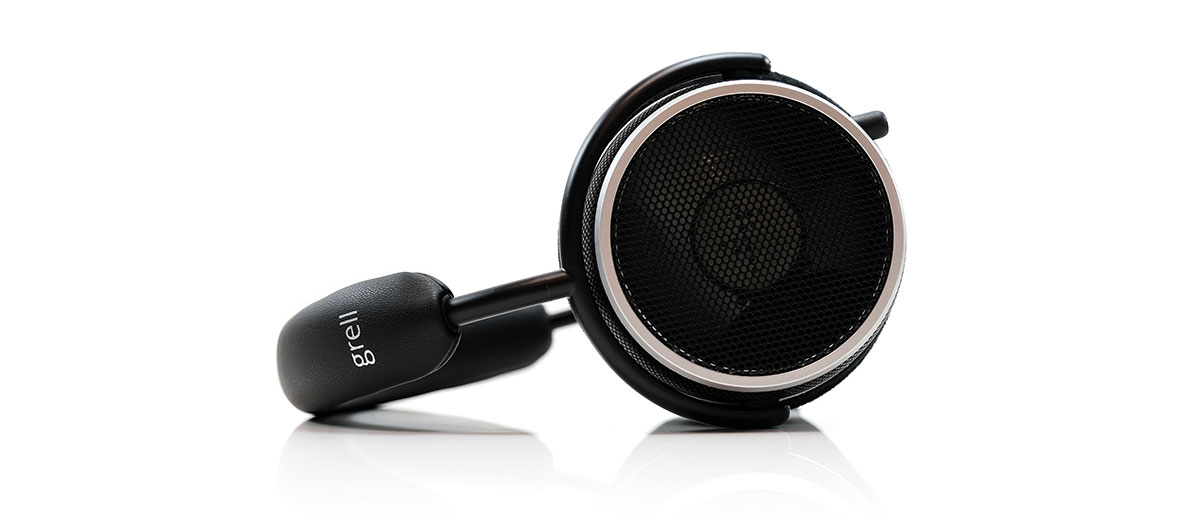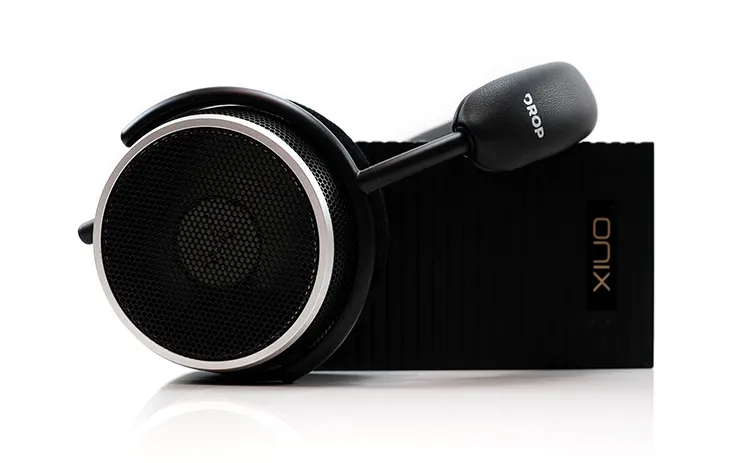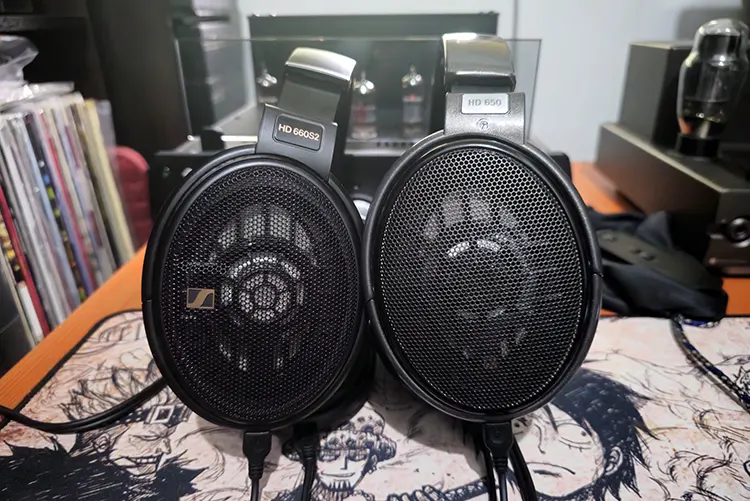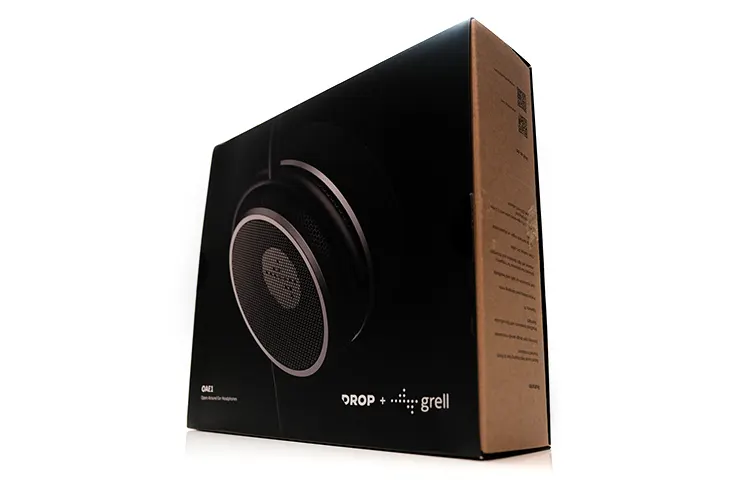Synergy
I tried a broad range of portable and desktop systems from a $200 dongle DAC, the Cayin RU7, right up to the $30k dCS Lina system so I did check if the OAE1 could scale with more power and if it could cope with the amount of detail being thrown at it with top tier systems.
Power
I drew two conclusions from the testing. The first is indeed power. The OAE1 might seem modest at 38Ω impedance but that 106 dB/Vrms does mean you are pushing up the dial to get suitable listening levels.
More so if you stick to the single-entry 3.5mm connection where portable sources are generally less weaker.
That does not mean you should ignore single-ended PO outputs. By all means, plug it into the 600mW capable Chord Electronics Mojo 2 which will produce a satisfactory dynamic sound with good energy.
Rather, the weaker the output power gets the less holographic the OAE1 sounds with reduced control over its bass performance which is where you do not want to go with this set of headphones.
Coloration Preferences
And with that, the second conclusion is that no matter the power level, pick a source known for a clean neutral performance. One that is tight on the lows, airy in the mids, and with good treble extension.
A great example of this was the iBasso DC-Elite and the Chord Electronics Mojo 2, two stock sound signatures that would be described as neutral to clean sounding.
The OAE1 loved these two dongles with a much improved treble fill and tighter bass control over softer iterations such as the relaxed and smooth presentation of the Cayin RU7 or the dense and weighty ONIX Mystic XP1 pairings.
I would avoid going warm and heavy from your source as this exacerbates the OAE1’s level of bloom and softens or veils the mids leaving out too much contrast and bite to the sound for my taste.
A subtle desktop example of this was the difference between the Ferrum ERCO (v1) and the OOR/WANDLA GSE setups.
Here the ERCO sounded a little softer with the OAE1, less convincing for imaging accuracy, with a bit more bass bloat compared to the very neutral and clear-sounding OOR/WANLDA combo.
And yes, the dCS Lina’s produced the cleanest, most resolving, holographic sound with the OAE1 but you would expect that.
It’s a very neutral high-energy pairing and will show off the OAE1 to the best of its abilities but highly unlikely to be a choice pairing for anyone unless you already have a Lina stack.
Select Comparisons
The following comparisons were completed using a mix of the Ferrum OOR/HYPSOS, the ERCO, and the Feliks Audio EUFORIA evo, with the dCS Bartok Apex and Ferrum WANDLA GSE for decoding.
Sennheiser HD 650
One of Sennheiser’s iconic releases during Axel Grell’s tenure, the Classic HD 650, was released in 2003, or 20 years ago and counting, but it did have a recent design refresh in 2020. This particular model here is the older pre-2020 model.
Technical
Both headphones are open-back dynamic driver designs but their driver implementation and tuning have different goals.
Given its age and development time, the HD 650’s 42mm driver positioning is designed to be relatively “centered” within the ear cup and mimics classic headphones ‘diffuse field equalized performance.
The 40mm dynamic driver in the OAE1 is pushed to the fore. This means its physical positioning inside the cup is off-centered and forward of the ear to create Grell’s “front-oriented diffuse field equalization,” which is intended to create a more spacious yet still natural sound.
Another key difference is the rated impedance of their respective drivers. The HD 600’s 300Ω rating makes it a darling of OTL amplifier fans whereas the OAE1’s more modest 38Ω provides a little more flexibility in terms of types of amplification.
Despite the HD 650 SPL seemingly less sensitive at 103 dB/Vrms, the OAE1’s 106 dB/Vrms on paper doesn’t quite ring true in practice with it requiring a little more juice to volume match the HD 650 in most instances.
Design
The HD 650 is lighter (265g versus 375g) and has a smaller form factor with oval cups and matching inner ear cavity openings from its velour pads.
Subjectively, it is the comfier of the two headphones to wear but I must caveat this with the fact I still have the original pads on my HD 650 which have softened up from some heavy rotation down through the years.
I wonder if the OAE1 pad materials will go through a similar process or due to its enhanced thickness and wedge design it will remain a relatively stronger clamping set of headphones.
I also have a similar sentiment for the OAE1 headband which could flatten over time in the same manner as the HD 650 headband.
I will say the OAE1 material choice is superior. Not that the HD 650 isn’t durable, but rather it’s a ‘plastic fantastic’ with some spring steel and metal meshes on the headband and cups as required. The plastic is tough but the die-cast zinc yokes on the OAE1 feel tougher.
It is a pity Sennheiser never introduced the OAE1’s 180-degree articulation to the HD 650, perhaps more so for the HD 600 which has been a studio favorite for several years.
A dual-entry cable system further differentiates the HD 650 design from the OAE1’s more flexible single or dual-entry option. I am not the biggest fan of Sennheiser’s 2-pin wide plastic connector system. The OAE1’s simpler 2.5mm TRRS connectors are the easiest of the two systems to use.
Performance
My preference between these two headphones depends on many variables. Broadly speaking, if you listen to regular music and are not a fan of big bass, then the HD 650 is going to win out.
The HD 650’s more subdued bass bloom up to 500Hz combined with a better lower treble fill from 5-7k and a slightly stronger 1-2k bump delivers a more natural and familiar tone for most headphone listeners.
Instrumental timbre has better upper harmonics overtones, offering more contrast and immediacy, especially on vocal clarity. The OAE1 is definitely deeper sounding but suffers from too much bass bloom with modern pop and pop with a degree of softness in the mids that can mask some detail.
These impressions are amplified when you go OTL with the EUFORIA evo, but perhaps this is an unfair comparison, as its treacly warm and heavy-handed bass response is not the best match for an already weighty OAE1 bass tuning.
However, reduce the bass energy with suitable recordings and move to a more neutral amplifier and things change a bit more in favor of the OAE1, and yes, I am talking about how spacious the presentation can be.
Old-school classical Charlotte Church or some Enya recordings sound a lot deeper and wider than the HD 650. You still get that high-contrast center image and vocal immediacy with the HD 650 but the space and separation from backing instruments are not as convincing.
For example, Charlotte Church’s 2000 recording, “O Holy Night”, sounds like it was recorded in a church on the HD 650 – a reasonably tall but narrow building. Whereas the OAE1 might sound a degree softer, however, that narrower church wall is converted into a sizeable, round-shaped arena.
Audeze MM-100
The Audeze MM-100 was released in 2023 with our review out in June 2024 and was also a 2024 Bang For Buck winner. It is part of the pro-orientated Manny Marroquin series which also includes the MM-500.
Technical
This time we are going in a different direction with the open-back single planar magnetic driver MM-100.
Planar versus dynamic usually means a very different listening experience in terms of timbre, technical capability, and power demands.
The MM-100 uses the company’s latest 90mm planar driver, a similar driver used in the more expensive MM-500 but with a different tuning. It is surrounded by an N50 Neodymium magnet setup in a single-sided Fluxor™ magnet array and an Ultra-Thin Uniforce™ diaphragm.
Technically, the MM-100 is easier to drive and more efficient than the OAE1. It has an impedance rating of 18Ω and an SPL of 98 dB/1mW which converts to around 115 dB/Vrms. The OAE1 will need more juice at 32Ω and 106 dB/Vrms or roughly around 91 dB/mW.
I should also mention that the MM-100 has a slightly lifted earpad ring to improve ventilation.
Design
At 475g, the MM-100 is a heavier headphone with a larger form factor and yet, despite some slight vertical pressure bias, it is a more comfortable headphone to wear courtesy of a slightly looser clamp and the all-important pressure strap just underneath its main headband arch.
I would have loved the OAE1 to have a pressure strap and slightly less clamp also though in its favor its pressure-resistant headband adjustment system does provide more options for smaller heads.
I find the MM-100 to be just a shade long for my head size but only just. If you have an even smaller head the MM-100 fitting might not work so well. The OAE1 can suit smaller heads and really large ones so of the two it has more flexible sizing options.
I think both headphone designs have used impressive material qualities at this price point. I will give an edge to Audeze just because their synthetic leather looks less ‘fake’ but otherwise the clean lines and subtle mix of metals work well for both headphones.
You might be interested to know that both the OAE1 and the MM-100 come with dual-entry socket systems at the base of the cups but do not require a dual-entry cable connection to work.
Both will accept single-entry options with the stock cable of each headphone a lightweight single-entry variant.
Performance
It is a similar situation or impression with the MM-100 in terms of better midrange clarity and superior lower treble fill, creating improved note definition through the mids and highs.
The OAE1 tends to sound a little soft in this region, smooth if you will, but no doubt under the influence of its heavier, warmer bass bloom.
You also have to add in some typical planar characteristics including the increased sense of speed and articulation, most noticeably in the 6-8k region where the MM-100 has more energy.
Of course, if you are sensitive to more aggressive treble then the OAE1 will sound the smoother, happier pairing but the coloration in the timbre dulls the edges a little and reduces the vibrancy of the performance.
Where the OAE1 devours the MM-100 is in the low-end up to 500Hz. It’s much the weightier and fuller of the two headphones through the lows and you can pick that up right away on atmospheric synth wave tracks such as Morgan Willis’s excellent “Blood & Roses” track from his 2015 ‘Miami Calling Album”.
This is a recording rich in low-end synth bass and pretty much underpins the timing throughout. It needs to be deep and heard loudly to sound correct in my opinion and the OAE1 gets it right whereas the MM-100 sounds much too shallow to drive the song correctly.
Speaking of atmospheric, the OAE1 excels on a macro level for staging compared to the MM-100 but loses out on micro-detail on closer inspection. Instruments are arranged more live-like on the OAE1 with some distance to the stage but nuanced spatial cues sound clearer on the more intimate MM-100 soundstage.
HIFIMAN DEVA Pro
The HIFIMAN DEVA Pro was launched in 2022 as an ‘upgrade’ on the regular DEVA Edition and though it is packaged with the Bluemini R2R wireless module we will be assessing it here as a regular set of wired headphones.
Technical
This is another similarly priced set of open-back planar magnetic headphones but this time with HIFMAN’s well-established super-thin NEO “supernano” diaphragm, (NSD).
Essentially a material that is light and low in mass, but tight, durable, and designed to produce high-quality fast-sounding dynamic response compared to regular planar diaphragms.
Since it is a second edition, it has the Stealth Magnet treatment. That means these magnets have differing physical shapes allowing sound waves to pass through from one side to another without creating any “interferences”.
The DEVA pro is a bit lighter on impedance at 18Ω compared to 38Ω and its 93.5 dB SPL rating is not too far away from the OAE1’s 106 dB/Vrms benchmark.
I presume the DEVA Pro is measured in mW, though officially there is no declaration. If correct then it would be almost 111 dB/Vrms making it the more sensitive of the two headphones though not hugely different in power requirements.
Design
Aesthetically, I have always liked the shape and lines of the DEVA Pro but you can tell the material choices are less premium than the OAE1. Overall, it feels less robust in the hand with reduced articulation in the cup swivel.
The DEVA Pro is a mix of silvery-dense plastics for the pivot blocks and matching anodized aluminum gimbals, large silver screws, and cup grills.
Both use synthetic leather on the headband but the bulky plastic pivot blocks give the DEVA Pro a cheaper look. Neither has the most premium-looking headband memory foam wrap but the minimalist styling on the OAE1 is more to my taste.
The DEVA Pro is lighter but only by a few grams. Still, it’s a comfier headphone to wear courtesy of its looser clamp. However, its lateral pressure bias dominates the vertical on my head so given the larger cup size the headband rarely sits flush on my scalp.
That means the OAE1 is a more secure fit on my head when moving around, whereas the DEVA Pro moves around a lot. Take from that what you will in terms of value. Some will prefer the secure fit, others the long-term comfort.
Just like the OAE1 and MM-100, the DEVA Pro is terminated as dual-entry but will work with a single-entry cable so long as you connect it to the left earcup. It only ships with one 3.5mm TRS terminated connector dual-entry SE stock cable so you will have to buy a single-entry cable if you want to go that way.
Performance
Let’s start with the OAE1 advantages and yes it’s the size and depth of the soundstage but also the smoothness of the timbre with some setups.
The DEVA Pro is quite a neutral-sounding set of headphones but with some noticeable roll-off in the lows around 80Hz making this more of a mid-to-highs performer where I find it competes quite well, at least in terms of clarity and articulation.
However, its vocal positioning is rather intimate and stretched far from the backing instruments. They, in turn, have a narrower arrangement behind the forward vocal meaning the X-Axis of the soundstage pitters out a little compared to the OAE1’s more grandeur macro-staging presence.
However, like the MM-100 and HD 650, the DEVA Pro has that 5-8k fill that is lacking on the OAE1 so, it has more contrast in its note timbre creating a cleaner more vibrant vocal quality.
Can it sound a little rough on the edges? It depends on your setup. For this comparison, I used the WANDLA GSE with the OOR which created a very neutral and clear sound from the DEVA Pro but one that was also lacking in weight on the lows.
The staging from the DEVA Pro thus felt shallower and punchier rather than the OAE1’s fuller and weightier performance.
I would pick the DEVA Pro for complex intimate performances, where you want that speedy planar to deliver every note well-defined and separated. I would go with the OAE1 if I wanted a smoother deeper sound with better X-axis presence.
My Verdict
The Drop + Grell OAE1 is an affordable and attractive-looking set of open-back dynamic driver headphones with a unique approach to presenting sound.
It challenges accepted conventions around diffuse field tuning so if you are in the mood to try something different then the OAE1 fits the bill and then some.
It excels at macro staging, pitching deeper and wider than comparably priced alternative headphones, and has a very smooth and weighty tonal quality that can, with the right recordings, involve and impress the listener.
To the conventional headphone listener, it can also sound (and fit) challenging, uneven, and lacking in midrange clarity.
The OAE1 might not be enough to sway you from traditional headphones but it might be a good choice to add to an existing collection.
Because if nothing else, it has a memorable sound signature and right now, we need creative individuals to take a chance and fashion something different in this hobby.
Something that, like the OAE1, stands out and might provide a stepping stone to a headphone that further refines what seems to be a promising idea.
Drop + Grell OAE1 Technical Specifications
- Headphone type: Open-back
- Ear coupling: Over-ear
- Drivers: Biocellulose dynamic drivers
- Sound characteristic: Front oriented diffuse field equalization
- Adaption to the individual hearing curve: Soundfield pinna interaction
- Nominal impedance: 38 ohms
- Frequency response: 12 – 32,000 Hz (-3 dB), 06 – 44,000 Hz (-10 dB)
- Sound pressure level (SPL): 106 dB (at 1 kHz 1 VRMS)
- Total harmonic distortion (THD): 0.05% (at 1 kHz 100 dB)
- Weight (without cable): 375 g







